Follow “Electronic Engineering Magazine” and add the editor’s WeChat
Regional groups are now open, please send messages 【Shenzhen】【Shanghai】【Beijing】【Chengdu】【Xi’an】 to the public account
In recent years, STMicroelectronics (ST) has been very active in the Chinese market. From collaborating with Huahong Semiconductor to establish a 40nm STM32 production line, to jointly building a silicon carbide (SiC) front-end manufacturing base in Chongqing with Sanan Optoelectronics, and continuously expanding the backend production line in Shenzhen… A series of localization layouts confirm the deep advancement of its strategy of “In China, For China”.
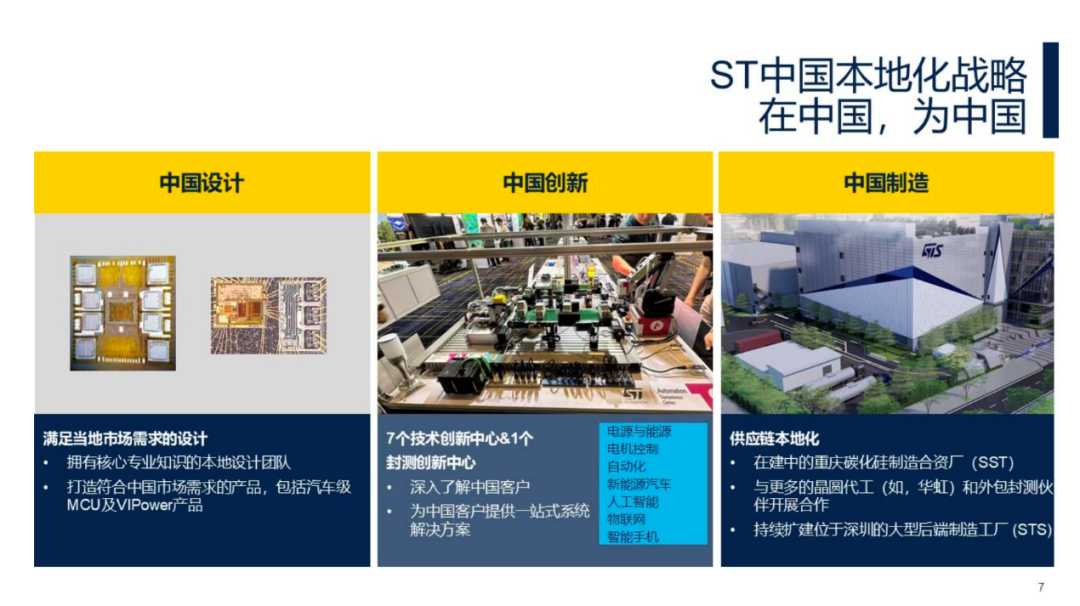
The STM32 Summit held in May in Shenzhen is a showcase of the phased achievements of this strategy — not only detailing four new products but also systematically interpreting the “new ecology of dual supply chains at home and abroad” for the first time, injecting new momentum into the Chinese embedded industry while demonstrating its determination to ensure supply security for Chinese customers in a complex geopolitical environment.
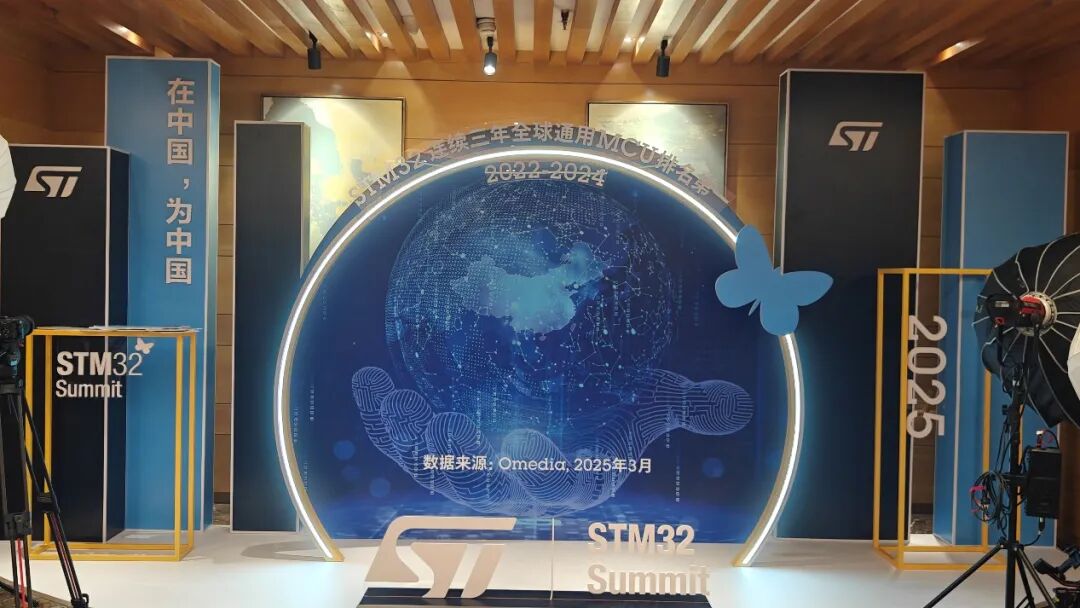
“Our commitment to the Chinese market is long-term and steadfast.” At a media communication meeting, Arnaud Julienne, Vice President of the IoT/AI Technology Innovation Center and Digital Marketing of ST’s Microcontroller, Digital IC, and RF Products Division (MDRF) in China, emphasized: “Our core goal is to build a supply chain system in China that is fully aligned with global standards.”

Arnaud Julienne, Vice President of the IoT/AI Technology Innovation Center and Digital Marketing of ST’s Microcontroller, Digital IC, and RF Products Division (MDRF) in China
Julienne revealed that two years ago, ST sent a hundred factory experts to Huahong Hongli, replicating European production line standards from equipment debugging to process parameters, ensuring that STM32 chips produced in China have zero differences in electrical characteristics, reliability, and other core indicators compared to overseas products. This investment is particularly critical in the current context of increasing geopolitical uncertainty, as he stated: “When customers need export products, we provide chips from overseas production lines; when customers focus on the domestic market, the Chinese supply chain can respond quickly — this flexibility in production capacity is something competitors cannot offer.”


Four Major New Products: Covering All Scenarios from Entry-Level to High-End Innovations
The four new products released at this summit are developed based on the “In China, For China” strategy, covering all scenario needs from entry-level to high-performance.
1. STM32C0 Series: Redefining the Value Benchmark for Entry-Level MCUs
As the new cost-effective representative of the STM32 family, the STM32C0 series aims to “replace mid-to-high-end 8-bit platforms,” achieving a breakthrough of “32-bit performance at 8-bit cost.” This series offers six sub-models, with Flash memory up to 256KB, RAM up to 36KB, and a working temperature range of -40°C to +125°C, covering price-sensitive scenarios such as small appliances and consumer electronics, and providing a long-term supply guarantee of 10 years.
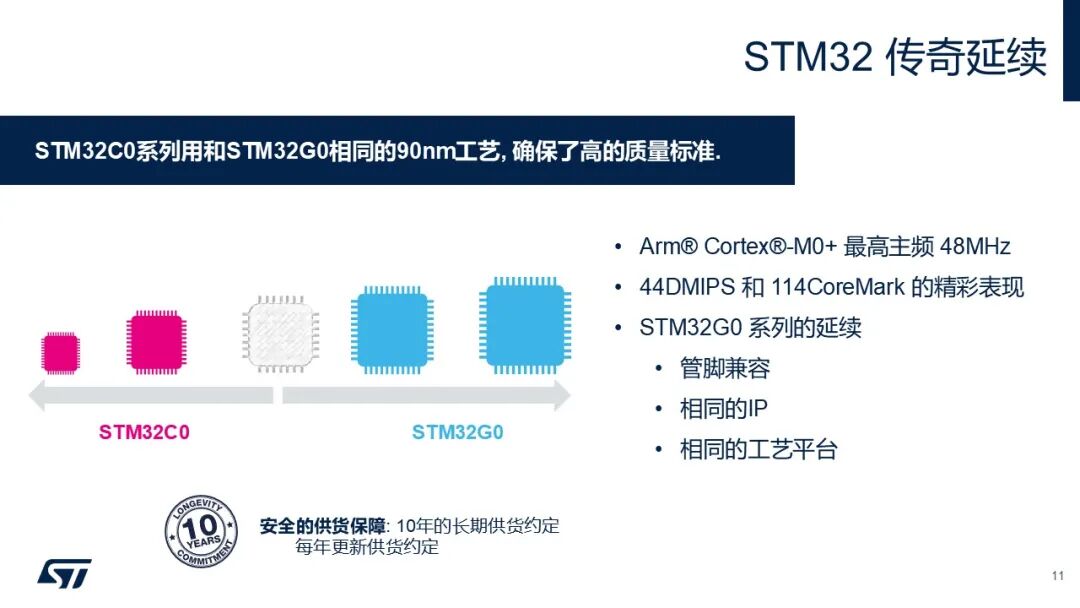
Yan Tao, Technical Marketing Manager of ST’s Microcontroller, Digital IC, and RF Products Division (MDRF) in China, pointed out during the product introduction that this series uses the same 90nm process as the STM32G0, equipped with a Cortex-M0+ core, a main frequency of 48MHz, and a CoreMark score of 114, while controlling the BOM cost at a level comparable to high-end 8-bit MCUs. Its pins are fully compatible with the STM32G0, supporting engineers to easily achieve a smooth migration from STM32G0 to C0. Additionally, the STM32C092 features a new CAN FD interface with a transmission rate of up to 8Mbps, which is 8 times faster than traditional CAN 2.0, enabling low-cost networking for industrial equipment.
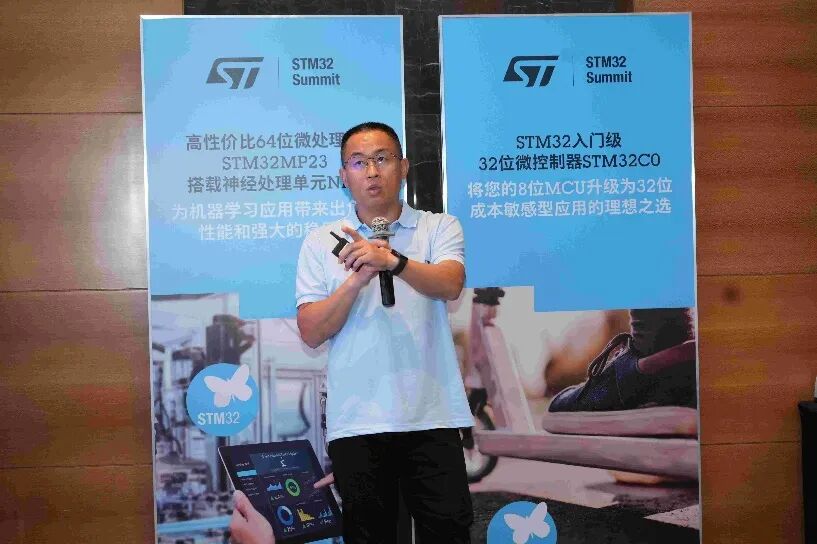
Yan Tao, Technical Marketing Manager of ST’s Microcontroller, Digital IC, and RF Products Division (MDRF) in China
In terms of packaging, the STM32C0 series offers a rich variety, covering multiple options from 8 to 64 pins, including small and thin QFPN and BGA packages, easy-to-handle SO8N and TSSOP20 packages, as well as commonly used LQFP packages, fully meeting the diverse needs of different application scenarios.

The STM32C0 is suitable for entry-level graphical applications, and with the TouchGFX graphical interface development tool, it can upgrade basic monochrome LCD screens to full-color touch screens. Additionally, to address developers’ pain points, a low-cost development board NUCLEO-C051C8 is provided, which, together with the CubeMX graphical configuration tool, can generate code with one click, greatly reducing the threshold for embedded development.
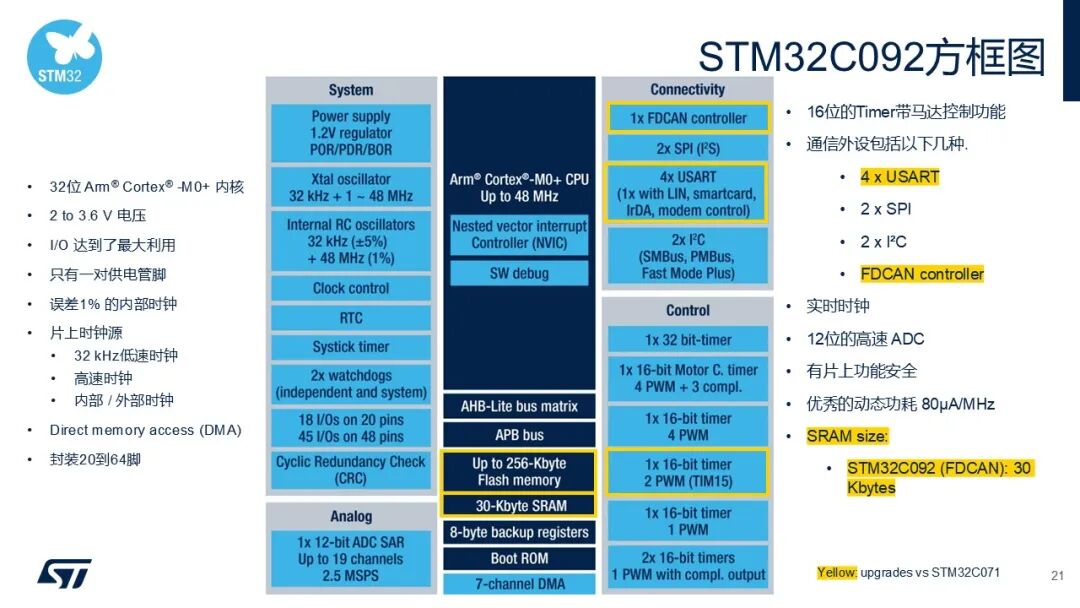
“Even beginners can quickly get started through visual configuration, significantly reducing the difficulty of embedded development,” Yan Tao emphasized: “We have launched the STM32C0 first, and we will definitely introduce similar products in the future to capture our rightful share in this market.”
2. STM32U3 Series: Ultra-Low Power Starts a Battery Life Revolution
In the fiercely competitive ultra-low power IoT market, the STM32U3 refreshes the industry energy consumption benchmark with “near-threshold voltage technology,” ensuring dynamic power optimization while supporting industrial temperature up to 105 degrees.
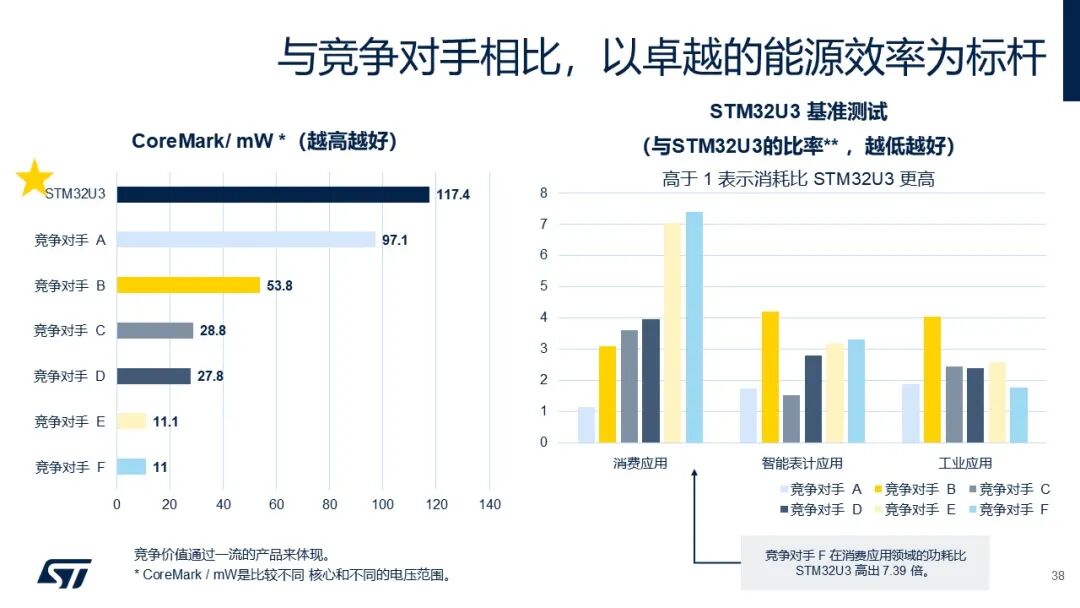
Zhang Ming, Technical Marketing Manager of ST’s Microcontroller, Digital IC, and RF Products Division (MDRF) in China, introduced that the core logic of this series can operate at an ultra-low voltage of 0.65V, with dynamic power consumption as low as 9.5μA/MHz (at a main frequency of 48MHz), achieving a 5-fold efficiency improvement over the previous generation STM32L4, with a CoreMark/mW of 117, far exceeding competitors’ 97 points. In consumer applications, similar industry products consume 5 times more power than U3; in metering applications, power consumption is 3 times that of U3; in industrial applications, power consumption is 2.5 times that of U3. Through Adaptive Voltage Scaling (AVS) technology, the chip completes optimal voltage calibration during production, requiring no software intervention, further saving development time.

Zhang Ming, Technical Marketing Manager of ST’s Microcontroller, Digital IC, and RF Products Division (MDRF) in China
This extreme energy efficiency makes it shine in scenarios such as smart metering and medical devices, extending battery life in activity tracking devices by 7 times, and by 4 times in smart meters. For example, the battery life of gas meters can be extended from the traditional 5 years to 20 years, and continuous glucose monitoring devices (CGM) can achieve 7 days of battery life.

In terms of security, the STM32U3 also performs excellently. It adds security mechanisms such as Coupling Connection Bridge (CCB) and Hardware Unique Key (HUK), assigning a unique and secure identity to each device during chip production, achieving hardware protection of keys, effectively enhancing device authentication and anti-cloning capabilities, meeting regulatory requirements such as the Network Resilience Act, and will be certified in the future through PSA Level 3 and SESIP Level 3 standards.
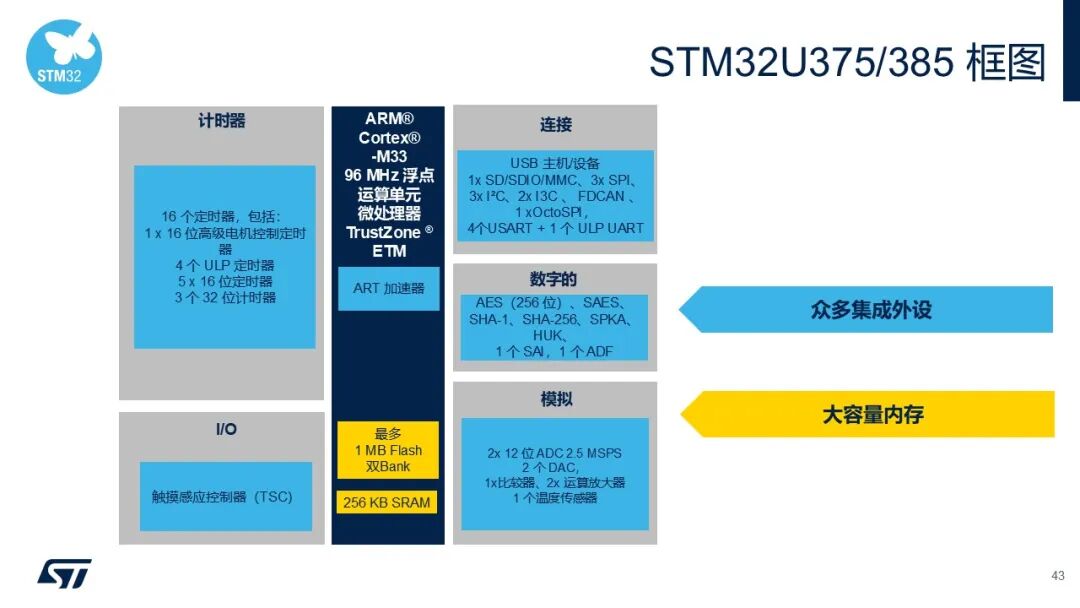
In addition, the STM32U3 is equipped with rich peripheral resources, including I3C and FDCAN interfaces, supporting up to 1MB Flash and 256KB RAM, and providing various packaging forms from 32PIN to 100PIN, widely applicable in battery-powered devices such as industrial smart homes, medical devices, smart meters, and consumer electronics.
“In industrial GPS tracking devices, U3 can reduce sleep power consumption by 50%, which is crucial for solar-powered outdoor devices.” Additionally, Zhang Ming specifically mentioned that its Stop3 mode power consumption is only 1.6μA, supporting a wide temperature range from -40°C to 105°C, suitable for harsh scenarios such as industrial GPS trackers. In the future, it will integrate an AI co-processor to achieve a dynamic balance between energy efficiency and performance.
3. STM32MP23: A Cost-Effective Computing Power for the Edge AI Era
As a “cost-optimized version” of the STM32MP25, the STM32MP23 continues the dual-core Cortex-A35 (1.5GHz) + Cortex-M33 (400MHz) architecture, achieving cost reduction through streamlined peripherals. This series supports 16-bit DDR4/LPDDR4/DDR3L memory, with a maximum addressing space of 4GB, allowing flexible allocation of on-chip resources to meet complex industrial application needs.

Huo Sun, Product Marketing Manager of Microprocessor Products at ST’s Microcontroller, Digital IC, and RF Products Division (MDRF) in China, pointed out that in terms of graphics and AI processing capabilities, it retains a 0.6 TOPS NPU and a 400MHz 3D GPU, supporting H.264 hardware decoding, meeting lightweight AI needs in industrial vision and smart home control. Additionally, dual Gigabit Ethernet (supporting TSN), FDCAN, and Octo SPI interfaces not only meet the stringent real-time requirements of industrial automation but also support human-machine interfaces, image processing, and lightweight AI inference tasks in smart homes and smart cities.
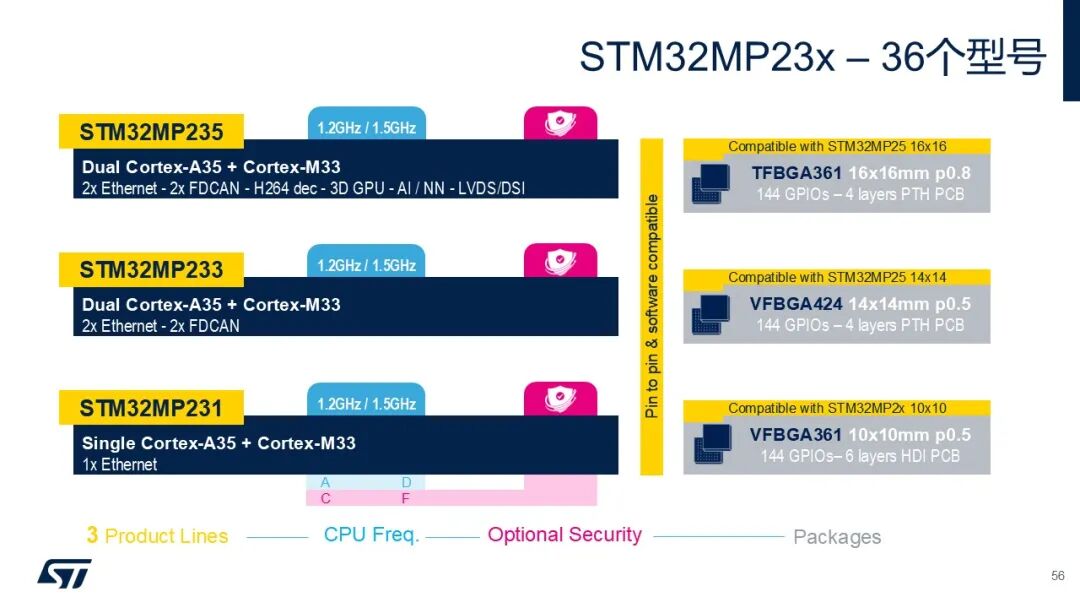
Huo Sun, Product Marketing Manager of Microprocessor Products at ST’s Microcontroller, Digital IC, and RF Products Division (MDRF) in China
“We optimize energy efficiency through heterogeneous computing, with A35 handling complex tasks and M33 responsible for real-time control, significantly improving system response speed in industrial PLCs,” Huo Sun said.

In terms of software ecosystem, the STM32MP23 supports the OpenSTLinux system, extending the software support cycle from 2 years to 5 years, aligning with the long lifecycle needs of industrial equipment. Additionally, resources such as the X-LINUX-AI extension package and ST Edge AI model library further simplify the deployment and optimization process of AI models, enabling developers to quickly integrate AI functions into applications.
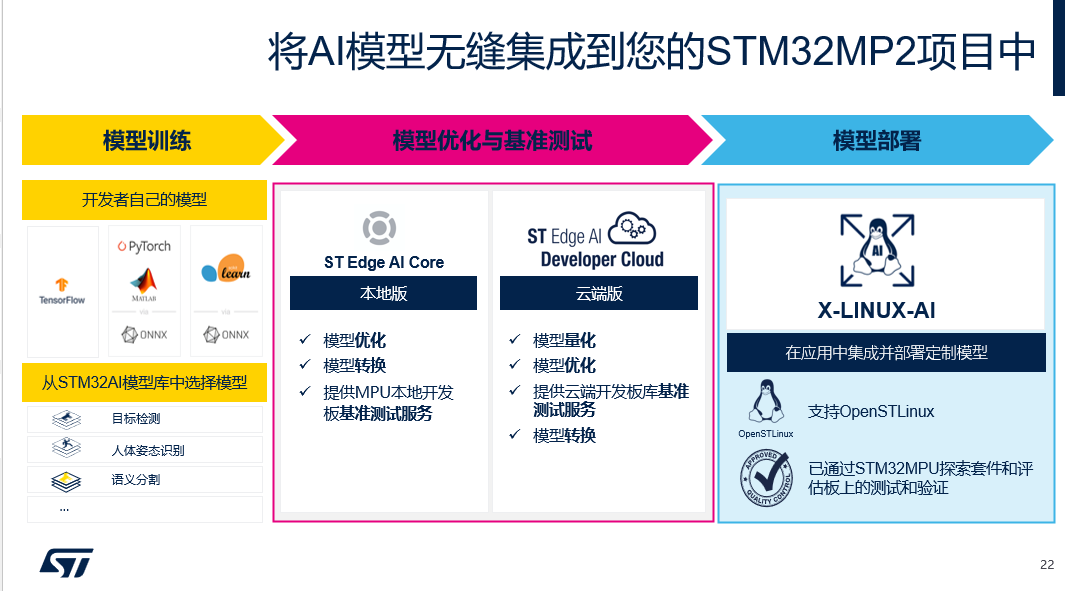
Furthermore, Huo Sun emphasized: “We provide a complete toolchain from model training to deployment, allowing customers to directly call the ST Edge AI model library to quickly achieve functions such as object detection and semantic segmentation.”
4. STM32WBA6: A Versatile Player for Multi-Protocol Wireless Connectivity
Chen Deyong, Director of STM32 Wireless Products at ST’s Microcontroller, Digital IC, and RF Products Division (MDRF) in China, introduced the STM32WBA6 series, focusing on wireless short-range connectivity applications, making it a “protocol-agnostic” solution for smart homes and industrial IoT.

Chen Deyong, Director of STM32 Wireless Products at ST’s Microcontroller, Digital IC, and RF Products Division (MDRF) in China
This chip fully supports 2.4GHz technology, covering Bluetooth® Low Energy 5.4, Zigbee R22/23, OpenThread 1.3, and Matter 1.4, with built-in high-capacity storage of up to 2MB Flash and 512KB RAM, as well as up to 86 GPIOs, providing strong hardware support for complex wireless applications. It can run multiple protocol stacks simultaneously, flexibly adapting to various scenarios such as wearable devices, smart homes, and industrial sensors.
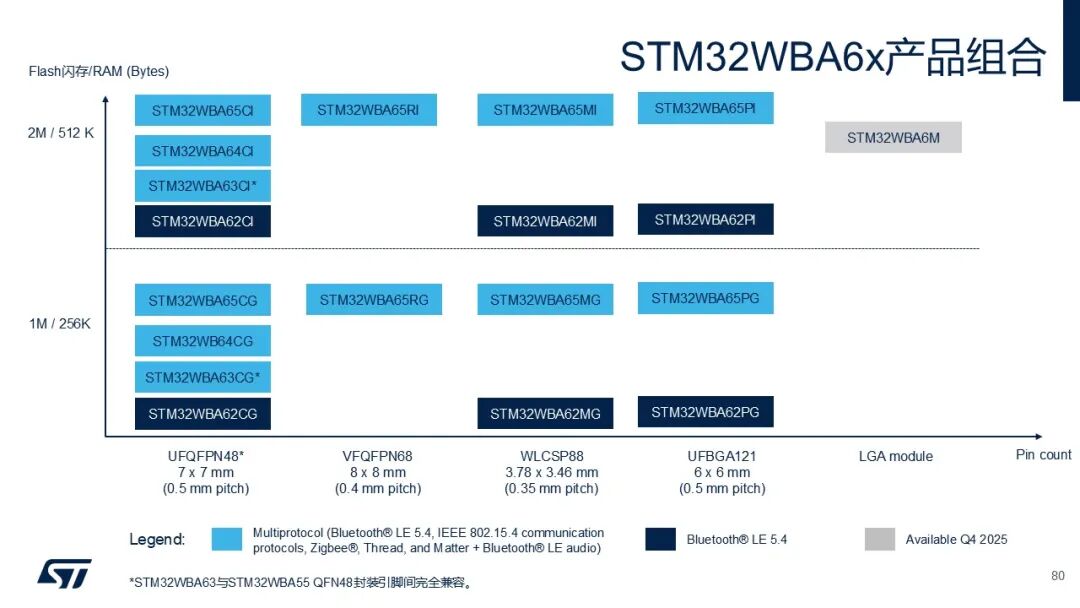
In terms of RF performance, the WBA6 supports +10dBm output power, with receiving sensitivities of -98dBm (Bluetooth® LE 1Mbps) and -100dBm (802.15.4 250kbps), ensuring stable and reliable data transmission. At the same time, its power consumption performance is also excellent, with power consumption as low as 5μA in Stop 2 (64KB RAM retained) mode and only 1.25μA in standby mode, greatly extending battery life.
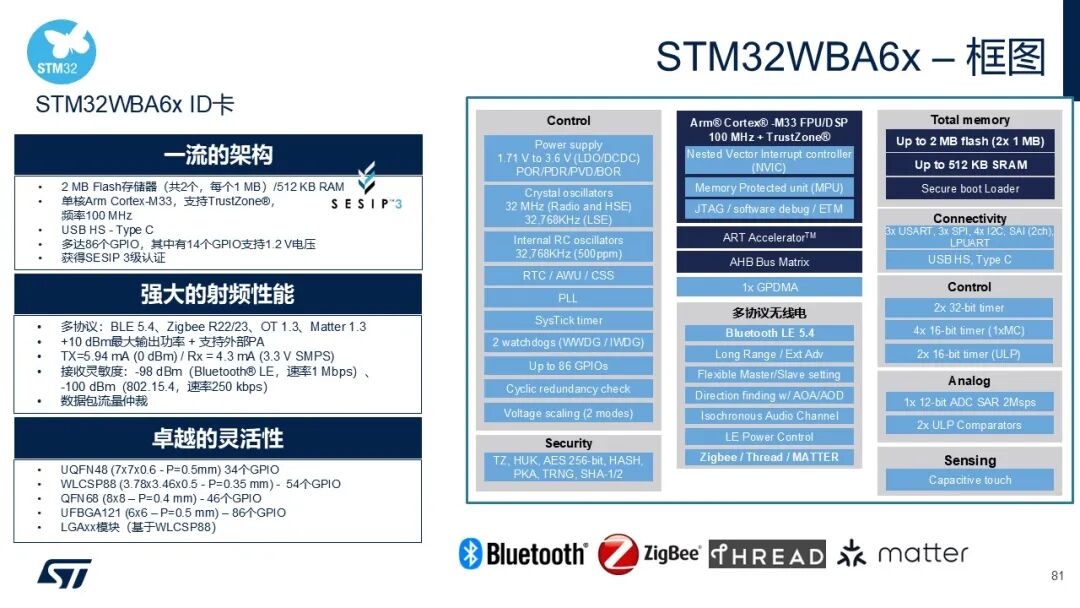
In terms of security, the STM32WBA6 has passed SESIP L3 and PSA L3 certification, featuring comprehensive security mechanisms including memory protection, side-channel encryption, secure debugging, and anti-side-channel hardware protection. It has a built-in hardware unique key (HUK) and side-channel attack protection design, meeting the requirements of the EU RED directive and future CRA regulations.
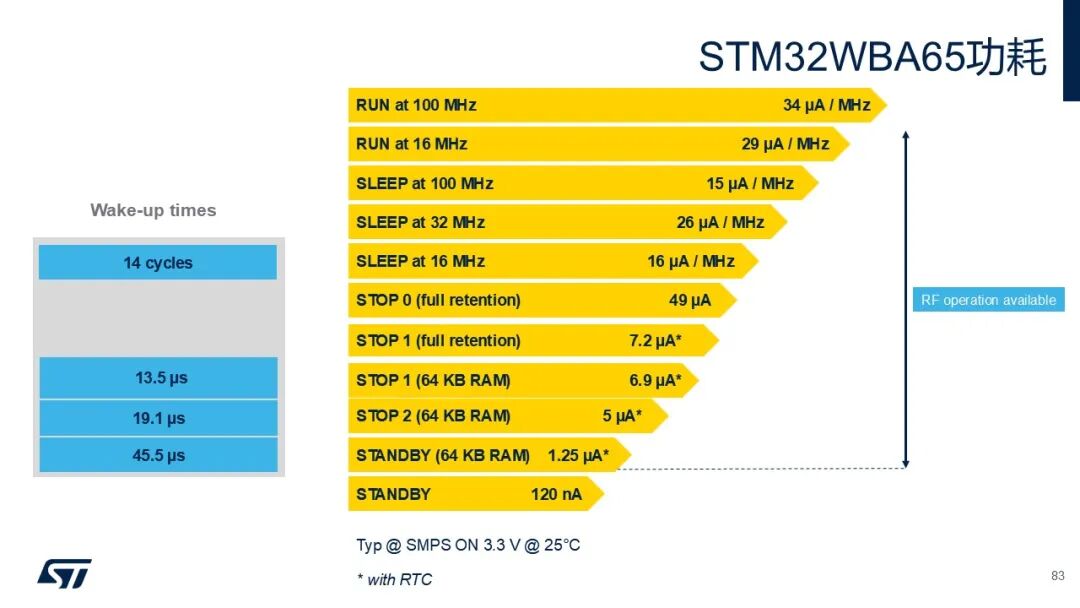
Chen Deyong provided an example: “In smart lock applications, its dual bank architecture supports seamless firmware updates, and the 2MB Flash can store multiple sets of encryption keys, meeting permission management needs in various scenarios such as homes and hotels. The HUK can achieve unique device authentication, resisting cloning attacks, and complies with EU CRA regulations.”

ST’s Comprehensive Layout and Technical Depth
During the media Q&A, the interviewees shared insights on issues of concern such as competition in consumer MCUs, trends in edge AI, and process paths.
In the face of fierce competition in the consumer MCU market, Yan Tao clarified that the positioning of the STM32C0 can actually meet most consumer application needs: “It is not about replacing the STM8, but about opening up new markets. The STM8 still has irreplaceability in the 5V traditional field, while the STM32C0 targets the upgrade needs of mid-to-high-end 8-bit users in 3.3V, such as small appliances and consumer electronics in large-scale scenarios, forming a complementary relationship between the two.” The STM8 series will continue to be retained and will not be discontinued. This differentiated strategy consolidates the existing market while penetrating emerging fields with 32-bit products.
In the wave of edge AI, STMicroelectronics demonstrates technological foresight. Wu Gang, Senior Manager of Microcontroller Applications and Products at ST’s Microcontroller, Digital IC, and RF Products Division (MDRF) in China, pointed out, “Relying solely on CPU computing power is no longer sufficient to meet customer demands for performance and power consumption; more and more are adopting this CPU + external co-processor approach, such as CPU + NPU heterogeneous implementation.”
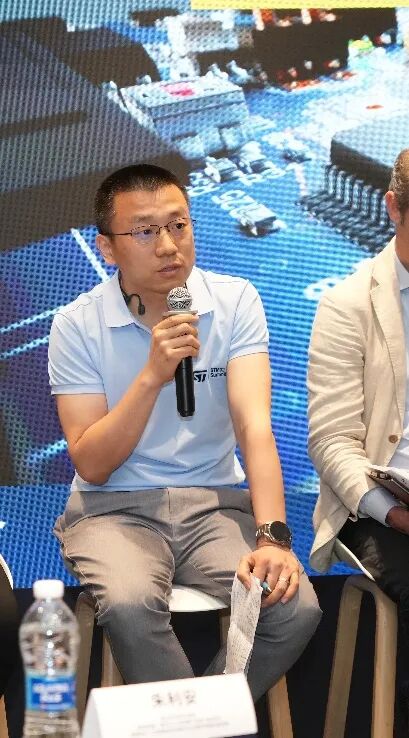
Wu Gang, Senior Manager of Microcontroller Applications and Products at ST’s Microcontroller, Digital IC, and RF Products Division (MDRF) in China
Additionally, he pointed out that the large data volume accompanying AI model processing poses higher requirements for memory capacity, and balancing performance and power consumption is also critical. The NPU of STM32N6 has a computing power of 0.6 TOPS, capable of running the YOLOv8N model for gesture recognition, supporting scenarios such as lightweight AI glasses; the next generation of products will further integrate self-developed NPU and CPU architectures to enhance computing power while maintaining low power consumption.
“We support various deep learning frameworks, such as Keras and TensorFlow™ Lite, and all frameworks that can be exported to ONNX standard format. Customers can use pre-trained models in the ST Model Zoo to quickly train their own data and deploy them using ST’s AI tools,” Wu Gang emphasized: “We do not blindly pursue computing power stacking, but optimize energy efficiency through CPU + NPU heterogeneous computing, for example, in wearable devices, allowing the NPU to focus on AI computing while the CPU handles control tasks, achieving a 1 + 1 > 2 effect.”
In addition, Arnaud revealed more about the process route: “40nm is currently the most cost-effective choice for STM32, but ST will not stop there. The MP2 series has adopted 16nm technology, and N6 is also 16nm. In the future, we will introduce 18nm PCM technology to achieve breakthroughs in storage density and energy efficiency. This dual-line strategy of ‘mature process ensures production capacity, advanced process promotes innovation’ ensures a balance between cost and performance for products.”
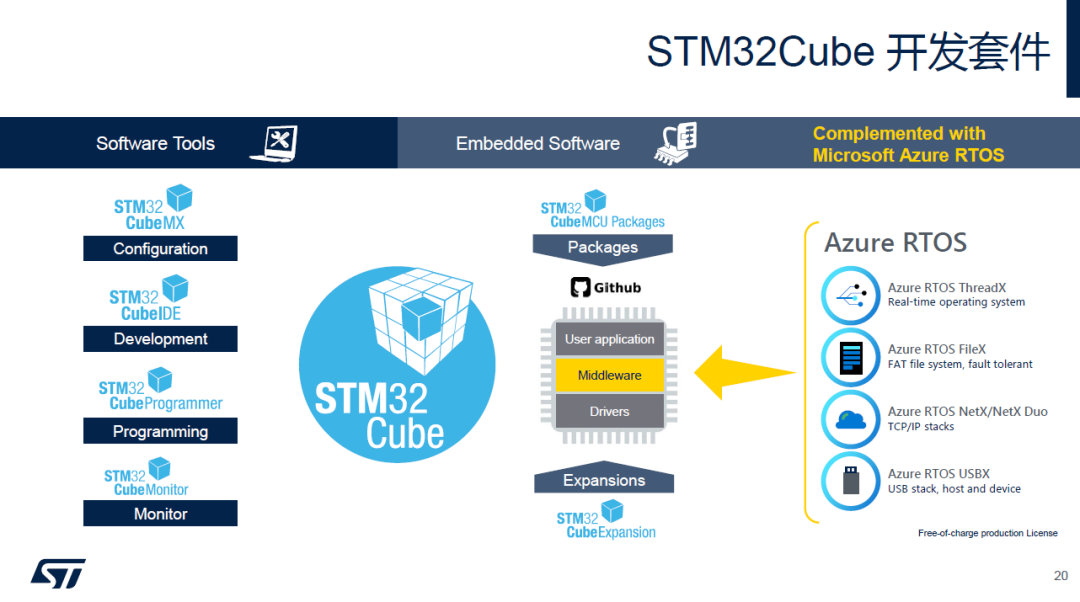
At this summit, ST also officially announced two new strategic directions for STM32Cube: returning to FreeRTOS as the main kernel while deeply integrating USBX, FileX, and LWIP to build a unified middleware solution; the third version of the STM32Cube plugin for Visual Studio Code, suitable for STM32Cube, has been officially released, with a new architecture adopting a modular design, greatly increasing user choice flexibility, more refined update management, easier operation, and lower risk.

Summary and Outlook: Dual Supply Chain Ecosystem Shaping China’s Future
The most significant signal released at the summit is the implementation of the “new ecology of dual supply chains at home and abroad.” Through Huahong Hongli’s 40nm production line, ST achieves full localization from silicon wafers to packaging and testing, with the STM32H7 and H5 series expected to enter mass production in Q4 2025, covering hundreds of models in the future.
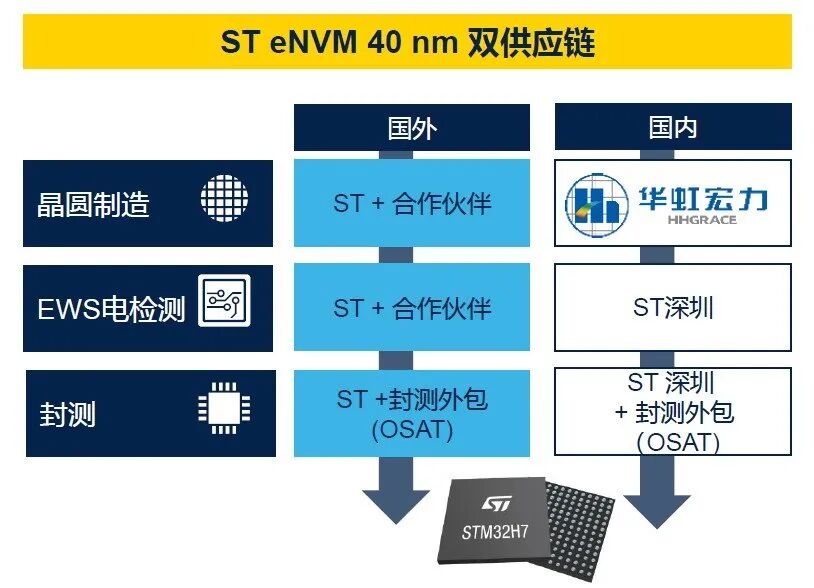
Arnaud emphasized: “This is not a simple transfer of production capacity, but a full-chain replication from technology to quality. Huahong’s production line uses the same equipment, the same process parameters, and even the same quality control processes as European factories.” This “dual-track” supply chain not only provides flexible choices for Chinese customers but also demonstrates ST’s determination to deepen its roots in the local market. As the trend of regionalization in the semiconductor industry intensifies, STMicroelectronics builds a supply chain system that combines resilience and efficiency with a strategy of technological homogeneity, quality consistency, and synchronized production capacity.
Looking ahead, with continued investment in localized R&D (such as the expansion of the Shenzhen backend factory) and deep collaboration with local ecosystem partners, ST is expected to achieve a leap from “local production to local innovation” in the Chinese market, providing more tailored embedded solutions for smart industry, new energy, and consumer electronics.
As the summit theme states, STMicroelectronics is writing a new chapter for STM32 in the Chinese market with the original intention of “In China, For China,” through technological deepening and ecological co-construction. This is not only a localization transformation of a multinational enterprise but also a microcosm of the deep integration of the global semiconductor industry with China’s innovation ecosystem — finding opportunities in openness and cooperation, creating value in autonomy and collaboration, perhaps is the way to break through in the post-globalization era of industrial development.